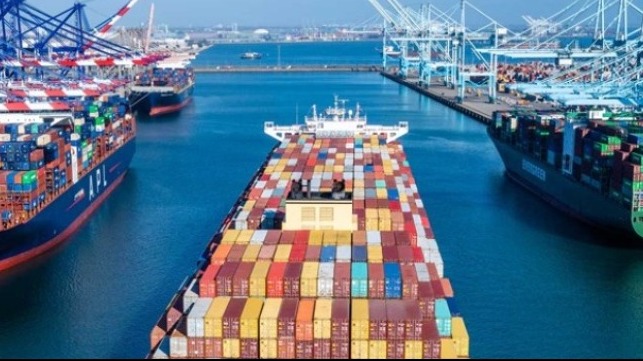Pacific Transit Times for Containers Doubled in Past Six Months

In another sign of just how difficult trans-Pacific shipping has gotten, new data reports that transit times between China and the U.S. West Coast ports have doubled in the past six months. Despite the recent attention and growing initiatives aimed at easing some of the congestion, the backlog continues to reach new records at the ports of Los Angeles and Long Beach with no short-term decline expected.
Between the second half of May 2021 and the beginning of October 2021, the average transit time from Chinese base ports to the U.S. West Coast ports of Los Angeles and Long Beach increased from 19 to 36 days, according to a new analysis from digital freight forwarding company Shifl. In some cases, Shifl says in the spring carriers were still making the transit in 16 days from port to port in May.
“Usually, a ship from Chinese base ports like Shanghai, Ningbo will take between 16-18 days to arrive and discharge cargo at U.S. West Coast ports,” said Shabsie Levy, Founder, and CEO of Shifl, commenting on the findings of the data analysis. “The increase in transit to 36 days, makes it extremely painful for businesses dependent on supply chains.”
They also noted that while the port-to-port transit time has nearly doubled that is only part of the problem. With the ports facing delays due to lack of adequate landside infrastructure, containers are sometimes stuck in closed areas within the port delaying inland transit even further leading to potential business-crippling conditions says Shifl.
“While we are in constant communication with our customers about the location, release, and delivery times of their shipments, when a ship spends 2-3 weeks waiting to unload, that’s a nerve-wracking situation for the customer,” said Levy.
With daily reports highlight the problems and challenges along the supply chain, the Biden Administration joined with the ports and their unions to announce new initiatives designed at easing the backlogs. The ports of Los Angeles and Long Beach both committed to moving to 24/7 operations along with the truck drivers and longshoremen unions to clear more containers out of the yards and speed them inland to their destinations. The ports of Seattle and Tacoma are also increasing their hours and opening on Saturdays to move containers, while ports such as Oakland are seeing a resurgence in vessel traffic.
After a few days of declines in the backlog, the Marine Exchange for Southern California reports that the number of vessels waiting to enter the ports again spiked to record levels highlighting the challenges that lay ahead. For the first time, 100 vessels (all types) are waiting to enter the Southern California ports. This is three higher than a record set a month ago when 97 ships were waiting on September 19.
With 57 ships at berth, there is a total of 157 commercial vessels in the ports of Los Angeles and Long Beach. The surge continues with another 45 vessels due to arrive in the next three days.
Since last Friday, October 15, the number of vessels holding beyond the anchorage rose by 10 ships to a total of 43. Among those ships that cannot even get to the anchorage are 33 containerships, beating the prior record of 29 boxships on September 20, as well as a few bulkers, tankers, and general cargo ships also waiting.
While there are a total of 70 containerships waiting outside the twin ports, a third of the vessels are considered to be mega-containerships, over 10,000 TEU each. Combined those 23 containerships have a rated total capacity of 281,000 TEU.
“With 40 percent of U.S. inbound containers moving through Los Angeles and Long Beach ports, efforts by the administration are rightfully focused on a critical node of the global supply chain,” says Shifl’s Levy. “The fact that the President of the world’s largest economy is getting involved in addressing this problem is already a huge relief for importers who have been struggling so much.”
